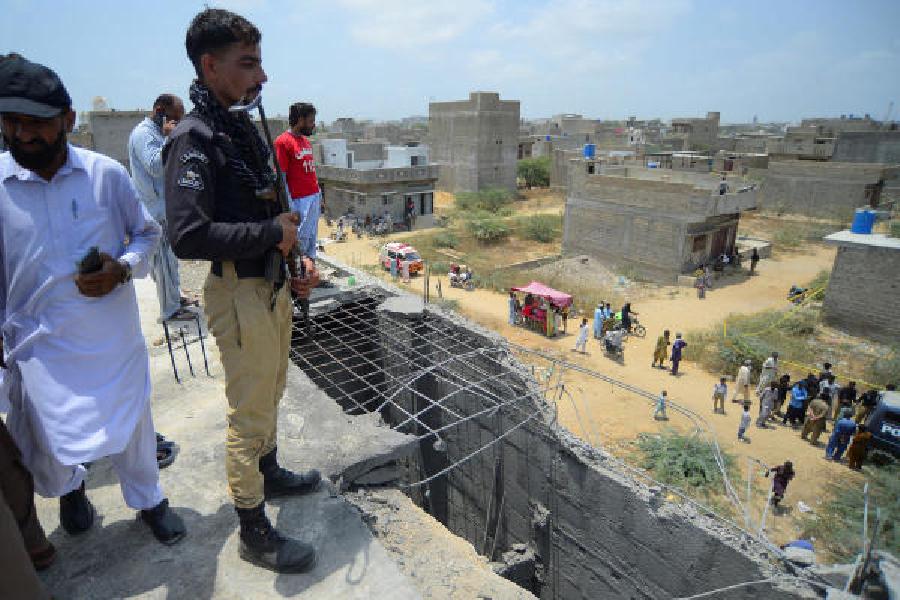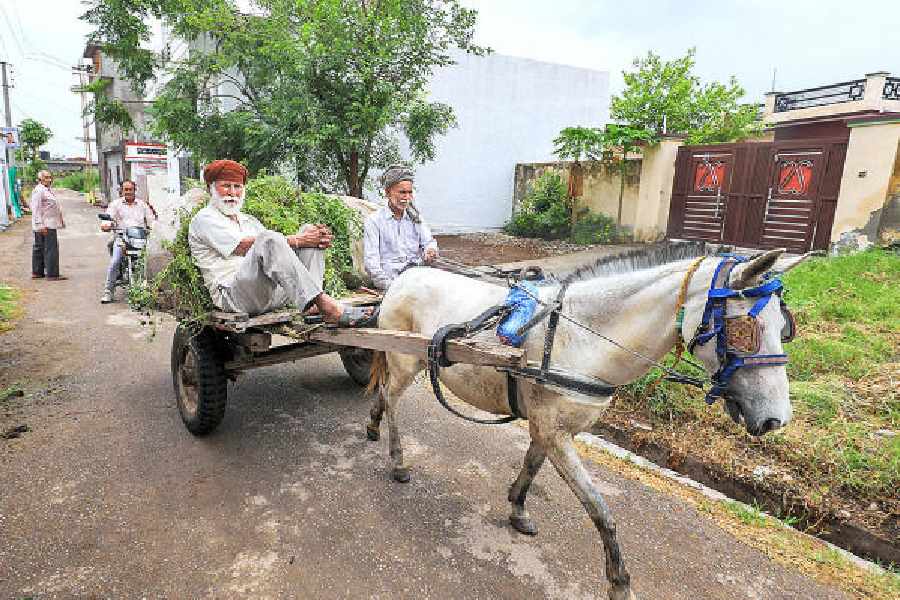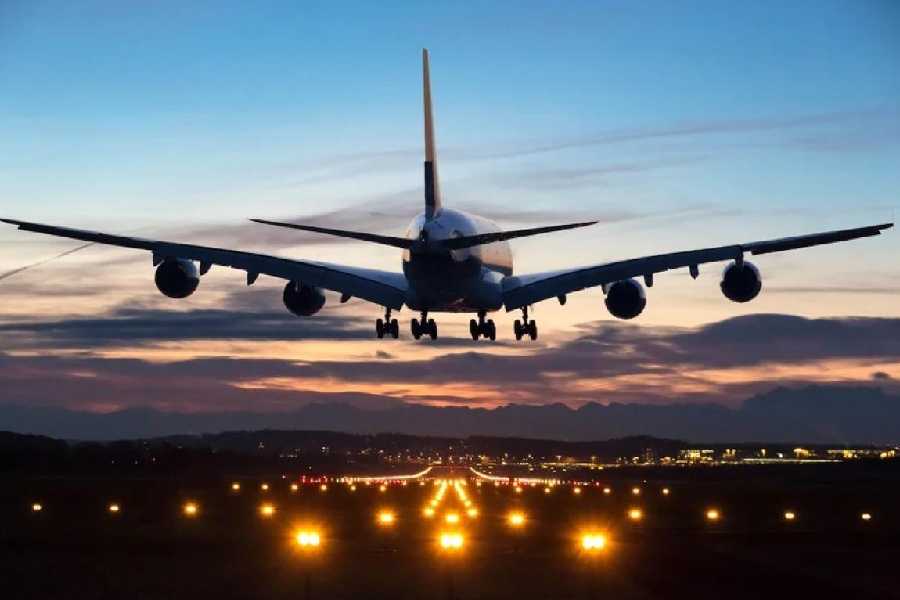 |
 |
 |
| (From top) Shiva-Durga at Lahabari; Durga flanked by Jaya-Bijaya under construction at Ramdulal Niwas; the dragon-like lion at the Basumullicks’ |
The next time you plan your pandal-hopping trip with novelty as the guideline, you would do well to cross the threshold of a few ancient family pujas. In a bipolar world of the flux-ridden baroari pujo and the inflexible barir pujo, there exists this cluster of deities which flies in the face of the very basic iconography of the Mahishasuramardini entourage.
Haldarbari, Bagbazar
According to archaeologists and mythographers, in the days of yore, Durga was worshipped alone, just like the other forms of the Mother Goddess. In fact, this is how it still is in north India. It is in the eastern part of the country that the cult of Parvati has gradually fused with that of Durga, thus giving her a family as her entourage.
An old touchstone image of Durga in her Mahishasuramardini form, hewn out of a two-feet-high slab, that is worshipped at the Haldar?s is unique in this respect. Two winged angels flank the fearsome Mahakaal above her while the tiny female figures at her feet might be the preliminary forms of Jaya-Bijaya, Parvati?s companions.
Rita Chatterjee, a daughter of the family, tells the story of how the statuette was recovered. ?While staying in Sahebgunj in Orissa, an ancestor of ours had dreamt that the goddess lay buried underground in a fisherman?s hut. The next morning, the excavation started. When the men were about to give up at sundown, the axe hit something. That?s why the statue has a hole in the back.?
Prankrishna Haldar of this family ranked among the early 19th century babus known for extravagance. ?He used to invite the British to his puja. Since he felt the size of the statue ill-befitted his stature, he ordered a separate clay image to be built, leaving this statue unattended in the thakurghar.?
Now, of course, the deity is worshipped in high veneration at the Bagbazar address.
Lahabari, Thanthania
The household deity is worshipped at the Laha?s as well. Hailed as Joy Joy Ma, the image is of ashtadhatu, with a golden coating. ?It is said that dacoits had stolen the statue. When they realised that it was not of gold, they left it by the wayside. The wife of an ancestor of the Lahas received an order to rescue the statue in her dreams,? says Alok Kumar Laha, whose turn it is to host the puja this year at his Bechuram Chatterjee Road residence.
This incident dates back to about 170-175 years ago. The puja began a century earlier. ?Banamali Laha started the puja in Baroshul area of Burdwan. We have proof of Madhumangal Laha continuing it at Chinsurah about 225 years ago.? Prankrishna Law shifted to Calcutta, bringing the puja with him.
Joy Joy Ma is dashabhuja. But a clay image is built every year, as well, of Parvati on Shiva?s lap. Alongside them are the four divine children. Both metal and clay images are worshipped together.
The puja over, Joy Joy Ma returns to the thakurghar while the clay image is immersed in the river.
Duttabari, Beadon Street
Shiva-samanwita Durga is worshipped at the Dutta household, Bholanath Dham, as well. Neither does she carry weapons nor is she accompanied by her mount or the warring asura.
The 101-year-old puja carries on the tradition of the legendary sea merchant Chand Saudagar, a worshipper of Shankar Bhabani. The actual image was conceived by another forefather Dhanapati Saudagar, also belonging to the kulin Gandhabanik clan.
A twist in fortunes caused the puja to stop. But Bholanath Dutta, an ancestor, revived the puja in 1905 in Varanasi. His sons brought the puja to Sovabazar.
Chhatubabu-Latubabu, Beadon Street
The presence of Jaya and Bijaya, the two companions of Parvati, is the highlight of the image at Ramdulal Niwas. The two female figures flank Durga poised on lotuses. Instead of holding the veena or the pot, their hands are raised in benison mode.
The puja was started by Ramdulal Dey in the 1780s. Engaged in the trade of buying sunken ships, he was known as ship sarkar. The family shot to prominence in early 19th century courtesy the luxurious habits of his sons Ashutosh (Satu) and Pramatha (Latu).
?Since the maker changes from time to time, we got the image photographed about 15 years ago and scrupulously follow it,? says Kalyan Deb, sixth in line from Ramdulal.
Basumullickbari, Radhanath Mullick Street
The puja at the Basumullicks? is turning 174. It was launched by Radhanath Mullick, the founder of Hooghly Dock Yard in 1831.
The characteristic feature of this image is the dragon-like white lion. A popular theory is that Vaishnava families (followers of Lord Vishnu) have their lions looking more like a horse or a dragon, while Shaivites (followers of Lord Shiva) have their lions like lions.
But Gautam Basumullick of the current generation is unwilling to accept this view. According to him, the phenomenon has circumstantial and sociological explanations. ?In those days, photography had not been invented, nor was communication improved. There were no lions in Bengal. So it was impossible for the artisan in a village to have known how a lion looked. So he created what he could imagine as a fierce form from descriptions in texts or by word of mouth. When people of the villages shifted to the city, they started modelling their Durga on what they had seen all their life back home.? The families, which have lions looking realistic, are of later origin, he points out.
This year, there is a bonus to mark the centenary of the Bangabhanga Andolan. Tagore had delivered a lecture on the thakurdalan on October 27, 1905, protesting the expulsion of students participating in the Andolan from government institutions. An exhibition on the Swadeshi agitation will commemorate the historic year.









